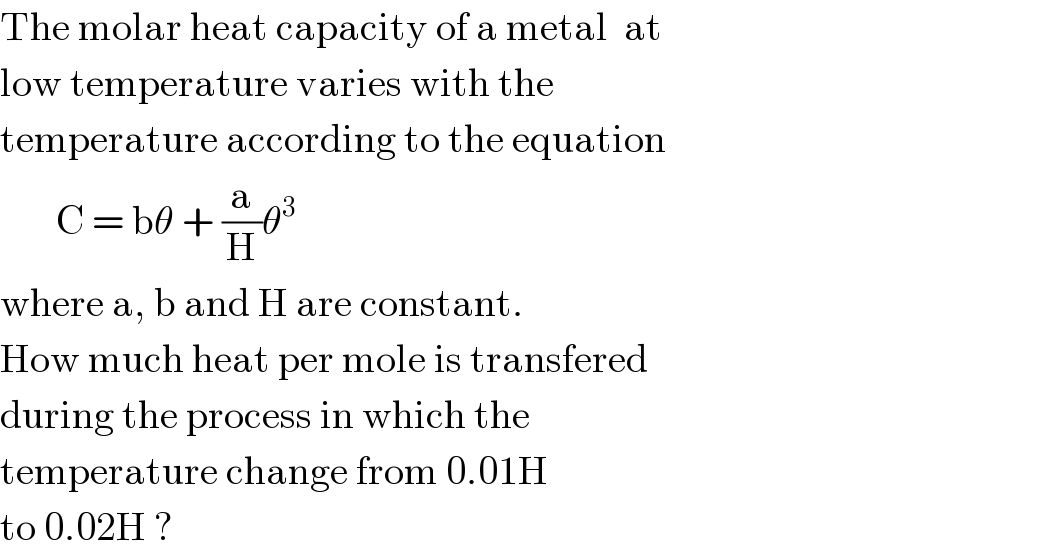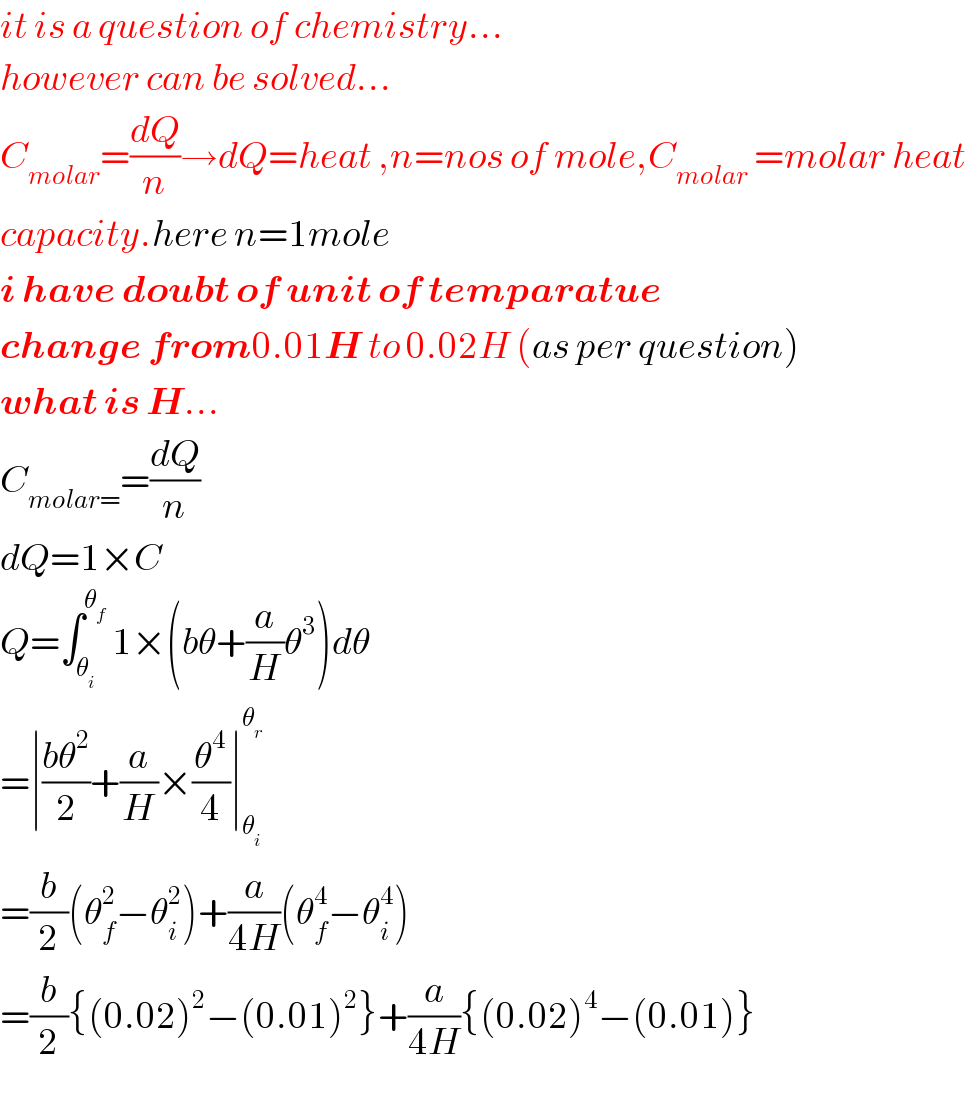Question Number 58216 by Umar last updated on 20/Apr/19

$$\mathrm{The}\:\mathrm{molar}\:\mathrm{heat}\:\mathrm{capacity}\:\mathrm{of}\:\mathrm{a}\:\mathrm{metal}\:\:\mathrm{at} \\ $$$$\mathrm{low}\:\mathrm{temperature}\:\mathrm{varies}\:\mathrm{with}\:\mathrm{the}\: \\ $$$$\mathrm{temperature}\:\mathrm{according}\:\mathrm{to}\:\mathrm{the}\:\mathrm{equation} \\ $$$$\:\:\:\:\:\:\:\mathrm{C}\:=\:\mathrm{b}\theta\:+\:\frac{\mathrm{a}}{\mathrm{H}}\theta^{\mathrm{3}} \\ $$$$\mathrm{where}\:\mathrm{a},\:\mathrm{b}\:\mathrm{and}\:\mathrm{H}\:\mathrm{are}\:\mathrm{constant}. \\ $$$$\mathrm{How}\:\mathrm{much}\:\mathrm{heat}\:\mathrm{per}\:\mathrm{mole}\:\mathrm{is}\:\mathrm{transfered} \\ $$$$\mathrm{during}\:\mathrm{the}\:\mathrm{process}\:\mathrm{in}\:\mathrm{which}\:\mathrm{the}\: \\ $$$$\mathrm{temperature}\:\mathrm{change}\:\mathrm{from}\:\mathrm{0}.\mathrm{01H}\: \\ $$$$\mathrm{to}\:\mathrm{0}.\mathrm{02H}\:? \\ $$
Commented by Umar last updated on 20/Apr/19

$$\mathrm{please}\:\mathrm{help}! \\ $$
Answered by tanmay last updated on 20/Apr/19

$${it}\:{is}\:{a}\:{question}\:{of}\:{chemistry}… \\ $$$${however}\:{can}\:{be}\:{solved}… \\ $$$${C}_{{molar}} =\frac{{dQ}}{{n}}\rightarrow{dQ}={heat}\:,{n}={nos}\:{of}\:{mole},{C}_{{molar}} \:={molar}\:{heat} \\ $$$${capacity}.{here}\:{n}=\mathrm{1}{mole} \\ $$$$\boldsymbol{{i}}\:\boldsymbol{{have}}\:\boldsymbol{{doubt}}\:\boldsymbol{{of}}\:\boldsymbol{{unit}}\:\boldsymbol{{of}}\:\boldsymbol{{temparatue}} \\ $$$$\boldsymbol{{change}}\:\boldsymbol{{from}}\mathrm{0}.\mathrm{01}\boldsymbol{{H}}\:{to}\:\mathrm{0}.\mathrm{02}{H}\:\left({as}\:{per}\:{question}\right) \\ $$$$\boldsymbol{{what}}\:\boldsymbol{{is}}\:\boldsymbol{{H}}… \\ $$$${C}_{{molar}=} =\frac{{dQ}}{{n}} \\ $$$${dQ}=\mathrm{1}×{C} \\ $$$${Q}=\int_{\theta_{{i}} } ^{\theta_{{f}} } \:\mathrm{1}×\left({b}\theta+\frac{{a}}{{H}}\theta^{\mathrm{3}} \right){d}\theta \\ $$$$=\mid\frac{{b}\theta^{\mathrm{2}} }{\mathrm{2}}+\frac{{a}}{{H}}×\frac{\theta^{\mathrm{4}} }{\mathrm{4}}\mid_{\theta_{{i}} } ^{\theta_{{r}} } \\ $$$$=\frac{{b}}{\mathrm{2}}\left(\theta_{{f}} ^{\mathrm{2}} −\theta_{{i}} ^{\mathrm{2}} \right)+\frac{{a}}{\mathrm{4}{H}}\left(\theta_{{f}} ^{\mathrm{4}} −\theta_{{i}} ^{\mathrm{4}} \right) \\ $$$$=\frac{{b}}{\mathrm{2}}\left\{\left(\mathrm{0}.\mathrm{02}\right)^{\mathrm{2}} −\left(\mathrm{0}.\mathrm{01}\right)^{\mathrm{2}} \right\}+\frac{{a}}{\mathrm{4}{H}}\left\{\left(\mathrm{0}.\mathrm{02}\right)^{\mathrm{4}} −\left(\mathrm{0}.\mathrm{01}\right)\right\} \\ $$
Commented by Umar last updated on 20/Apr/19

$$\mathrm{thank}\:\mathrm{you}\:\mathrm{so}\:\mathrm{much} \\ $$$$\mathrm{i}\:\mathrm{doughted}\:\mathrm{the}\:\mathrm{unit}\:\mathrm{of}\:\mathrm{temp}\:\mathrm{too} \\ $$
Commented by tanmay last updated on 20/Apr/19

$${most}\:{welcome}… \\ $$
